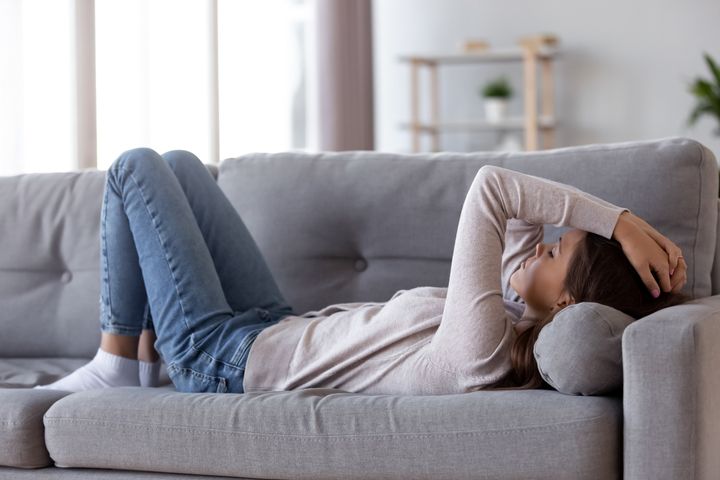
We’ve made it to the end of January and so far, I’ve stuck to my new year’s resolutions. I have quite a few: One is to read a book a week; another is to learn Spanish. ¿Por qué no? The third is to give up the chase for miracle cures for my chronic pain, and to read up on my body and brain instead.
Apparently up to 43% of us in the UK live with chronic pain. I can therefore assume that 43% of us probably woke up on New Year’s day feeling a familiar ache or shooting pain and thought, not another year of this shit?
I have been one of those people for 12 years now. My condition is called pelvic girdle pain – most common in pregnant women – and involves a whole joyful host of symptoms such as a sensitive vulva, stabbing pain upon movement and aching pelvis and inner thighs. I’ve alternately been told the problem is nerve pain, while others insist it’s skeletal. Maybe it’s both.
And no, before you ask, I don’t know what caused it, and before you suggest something, I’ve tried it: Doctors, physios, osteopaths, yoga instructors. I’ve bought lubes and magic wands (less Hogwarts, more stretching out the pelvic muscle) and vaginal dilators and herbal teas. I have a fancy pillow that I put between my knees in bed, and I tend to buy trousers that are generous around the crotch.
But a really meaningful change happened in December, when I had an appointment with a new physiotherapist on the NHS. Instead of prodding my poor pubic bone or making me bend this way and that – yes, I can touch my toes! – she recommended a book called Explain Pain by Lorimer Moseley and David Butler. Before we continued, she said, I want you to read that.
Ok fine, I yawned. I’d already been to a conference on pelvic pain in October and learnt a little there, but sure, why not. It’s not as if I really expected this physio to help me anyway.
Over the holidays, I not only read Testament of Youth and The Great Gatsby, but I also belted through Explain Pain. It said that we have different sensors in our tissues to interpret inputs, like changes in temperature, contact with chemicals, or being hit by a hammer. These sensors send different messages shooting up the neurones, first to the spinal cord, and if there’s enough activity there, up to the brain, which decides what message comes back down – pain, or a good dose of the lovely stuff e.g. opioids, to calm us down.
Amazingly, we are not hardwired to be in pain – our sensors regenerate every two to three days! I learnt that our brains and bodies love motion and moving in different ways: I promptly ditched my plan of doing absolutely no exercise (because it hurt) and signed up to a course of aerial yoga. (We can be active again by finding a baseline and gradually increasing what we do over time.) And I learnt that we have a ‘virtual body’ in our brain, where certain body parts are over-represented, become more sensitive and react disproportionately to certain inputs.
Importantly, the chronic pain we feel – whether it’s in the neck or the back or the vulva – is completely unrelated to the amount of actual damage we may or may not have in the body. In other words, pain is real, but it’s also all in the brain. This knowledge has – forgive the pun – blown my mind.
A lot of other things made sense after that short, intense course of brain science and physiology. I thought of all those miracle stories – the people who swear by their diet, or take up neuro-linguistic programming, or move to the desert and become reiki masters, or the person who invented their own special form of vaginal dilators with magnets. Those techniques or lifestyle changes are all great, but they may not have worked thanks to the magnets or reiki. It’s more likely they worked because these “gurus” re-trained themselves and shifted their mindset.
They may have realised they were not in danger when they felt pain, and that it was just the body’s way of protecting them from a perceived threat. With that knowledge, the fear and anxiety melted away. Instead of allowing themselves to be ferried between endless, rather clueless specialists, they took their education into their own hands. They were in control.
As the book illustrated, I have been past Avoidance City. I have sojourned in Denial Town. I have personally re-enacted that boom and bust graph, where I go hell for leather when I’m pain-free and then spend days, if not weeks, incapacitated and hobbling around like John Wayne.
I know now that knowledge – and moderation – is power. It seems easier to pay someone in a white coat to tell you what’s wrong, but it’s more empowering and much cheaper to read a book. Reading won’t heal your neural pathways overnight, but it’s the best start you can give yourself in 2020. In fact, it’s the easiest, cheapest and most effective New Year’s resolution you can make.
Rachael Revesz is a freelance writer and editor.